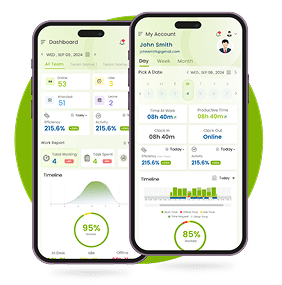It’s no secret that engaged employees tend to perform better and contribute positively to organizational success. But there’s a hidden risk.
When comparing engaged employees who are not thriving with those who are, the differences are striking. According to Gallup, those who aren’t thriving have a 61% higher likelihood of experiencing frequent burnout and a 48% greater chance of facing daily stress.
These statistics shine a light on a critical truth: engagement without well-being isn’t sustainable. And one of the most overlooked tools that can either support or sabotage employee wellness? Time tracking software.
So, why does well-being matter when it comes to time tracking? That’s the question we’ll explore in this blog. We’ll also look into:
What is Employee Wellbeing?
Why Does Well-being Matter in Time Tracking?
The Psychological Benefit of Time Tracking
How Time Tracking Can Help Prevent Burnout
Must-Have Time Tracking Features That Support Well-being
What Most Time Tracking Tools Get Wrong
-
Quick Checklist to Choose a Wellness-Friendly Time Tracking Tool
Business Benefits of Wellness-Focused Time Tracking
What is Employee Wellbeing?
Employee well-being refers to the overall mental, physical, and emotional health of individuals in the workplace. It includes key factors such as work-life balance, job satisfaction, and a supportive social environment. Prioritizing well-being is essential for fostering a positive, productive work culture that benefits both employees and the organization as a whole.
Why Does Well-being Matter in Time Tracking?
Time tracking has long been viewed primarily as a tool for tracking hours worked. However, in today’s evolving work culture, it’s becoming increasingly clear that time tracking must go beyond simple oversight. It needs to be a part of broader conversations about employee well-being and sustainable work practices.
Time Tracking as a Support for Healthy Work
When approached thoughtfully, time tracking becomes a supportive framework for maintaining healthy work habits and promoting overall well-being. It allows employees and managers to gain insight into not just how much time is spent, but how work patterns affect physical and mental health.
Wellness-aware time tracking can help:
Encourage mindful work habits
Prompt regular, restorative breaks
-
Support realistic workload distribution
Reinforce boundaries between work and personal life
Promote better time autonomy and focus
Risks of Ignoring Well-being in Time Tracking
When time tracking is used solely to monitor output without factoring in wellness, it can unintentionally create a harmful work environment. Here’s what can go wrong:

Encourages Unhealthy Work Patterns
An overemphasis on
hours logged often leads to employees working longer than
necessary and skipping breaks, increasing the risk of employee
burnout.

Blurs Work-Life Boundaries
Without wellness features
or break enforcement, employees may find it hard to switch off,
especially in hybrid or remote setups.

Increases Stress and Anxiety
Pressure to be “always
productive” fuels chronic stress, making time tracking feel
punitive instead of supportive.

Leads to Disengagement
When time tracking overlooks
well-being, employees may feel undervalued and disconnected from
their work and team.

Raises Turnover Rates
Unaddressed burnout and stress
eventually drive employees to leave, leading to higher hiring and
training costs.

Harms Organizational Performance
Disengaged or
overworked teams are less innovative, less accurate, and more
likely to
miss deadlines.

Damages Morale and Employer Brand
A company culture
that ignores well-being can lower team morale and damage
reputation, making it harder to attract top talent.
An Industry Shift Toward Wellness-Focused Time Tracking
To address these risks, many organizations and technology providers are rethinking how time tracking is implemented. A growing shift is underway from control-based systems to wellness-first platforms that support both productivity and health.
Modern time tracking tools now include:
Break reminders to reduce screen fatigue
-
Stretching or walking prompts to encourage physical activity
-
Workload analytics that help managers detect early signs of burnout
-
Custom wellness modules allowing for short, scheduled wellness activities
The Psychological Benefit of Time Tracking
Time tracking is often associated with productivity and accountability, but its impact goes deeper. When implemented with empathy and wellness in mind, time tracking offers powerful psychological benefits that support mental clarity, reduce stress, and improve overall emotional well-being.
Here’s how

Increased Self-Awareness
Time tracking helps individuals become more conscious of how they spend their day. This self-awareness encourages reflection on habits, time-wasters and energy peaks.
Benefit: Better control and clarity over your work habits.

Sense of Accomplishment and Progress
Seeing completed tasks and logged productive hours can improve confidence and motivation. It helps employees visualize their progress, even on days when the to-do list feels overwhelming.
Benefit: Builds motivation and a sense of accomplishment.

Reduced Anxiety Around Time Management
Without structure, time can feel chaotic, leading to stress and procrastination. Time tracking creates order, making it easier to plan, prioritize, and feel in control of the workday.
Benefit: Less overwhelm, more confidence in managing time.

Healthy Work-Life Boundaries
By logging when the workday starts and ends, employees can more clearly define boundaries between work and personal life especially in remote settings.
Benefit: Better balance and lower risk of burnout.

Support for Goal Setting and Time Autonomy
Well-designed time tracking tools encourage goal setting, focus blocks, and strategic planning. This fosters autonomy and motivation leading to job satisfaction and employee engagement.
Benefit: Builds autonomy and job satisfaction.

Validation of Effort
Many employees put in effort that goes unnoticed. Time tracking can validate that effort by documenting invisible tasks like research, communication or planning.
Benefit: Employees feel seen, valued, and appreciated.
How Time Tracking Can Help Prevent Burnout
Thoughtful time tracking isn’t just about tracking hours; when done with wellness in mind, it becomes a powerful tool to prevent burnout and promote sustainable productivity. In fact, companies that integrate wellness programs see up to 25% higher productivity in just six months (Gallup Workplace Study).
Here’s how wellness-focused time tracking can help prevent burnout:

Identifying Overwork and Excessive Hours
Accurate overtime tracking reveals when employees consistently work beyond healthy limits, such as extended hours, skipping breaks, or working late into the evening. Early identification of these patterns allows managers to intervene before burnout sets in.

Encouraging Regular Breaks
Wellness-oriented time tracking tools, like Desklog, prompt employees to take scheduled breaks for rest and wellness activities (stretching, walking, blinking, etc.). These breaks reduce mental fatigue and physical strain, keeping energy levels sustained throughout the day.

Promoting Workload Balance
Time tracking data provides insights into how employees spend their workday, highlighting potential imbalances. Managers can redistribute tasks or adjust deadlines to ensure no one is overwhelmed, fostering a more balanced and manageable workload.

Creating Awareness and Accountability
When employees see their time use clearly, they become more mindful of their work habits, recognizing when they push too hard or neglect self-care. This awareness encourages healthier behaviors and better time management.

Supporting Mental Health through Data
Burnout is not always visible. Time tracking reports can flag signs of disengagement, such as frequent idle times, reduced work hours, or erratic work patterns. These red flags allow early conversations and support for mental health.

Enabling Flexibility and Autonomy
Wellness-focused tracking respects individual rhythms by allowing employees to schedule their work and breaks according to what suits them best. This autonomy reduces stress and increases job satisfaction, lowering burnout risk.
Must-Have Time Tracking Features That Support Well-being

Smart Break Alerts
Automated reminders prompt users to take regular breaks after extended periods of focused work, helping reduce eye strain, mental fatigue, and physical discomfort. These alerts encourage healthy habits and prevent burnout by promoting rest and recovery.

Idle Time/Fatigue Detection
The system detects periods of inactivity or signs of decreased productivity, signaling potential fatigue or distraction. This feature helps users and managers recognize when it’s time to pause or switch tasks, preventing overexertion.

Pomodoro/Focus Timers
Built-in timers based on productivity techniques (like the Pomodoro Method) encourage users to work in focused intervals followed by short breaks. This structured approach supports sustained concentration while minimizing burnout risk.

Burnout Signals or Well-being Dashboards
Dashboards that visualize workload trends, overtime, and signs of burnout give both employees and managers insights into stress levels and work patterns. This data-based awareness helps enable timely interventions to support mental health
What Most Time Tracking Tools Get Wrong
| Issue | The Problem | A Better Approach | |
|---|---|---|---|
| 1. | Hours Over Outcomes | Tracks time, not results. | Focus on task completion and engagement. |
| 2. | No Break Support | Ignores need for rest and movement. | Include break reminders and wellness tips. |
| 3. | Data Overload | Too much data, no clarity. | Provide clear insights and visual reports. |
| 4. | Burnout Blind Spots | Misses signs of overwork. | Flag risks early and support balance. |
Quick Checklist to Choose a Wellness-Friendly Time Tracking Tool
Choosing the right time tracking tool with a focus on employee wellness can make a huge difference in productivity, morale and overall health. Use this checklist to find a tool that truly supports your team’s well-being:
Built-in Wellness Features
-
Does the tool include a dedicated wellness module or features like break reminders, stretching prompts, or blink breaks?
-
Can it schedule and customize short and long wellness activities (e.g., walking, snacking, eye exercises)?
Automated and Smart Break Reminders
-
Does the tool automatically remind employees to take breaks at regular intervals?
-
Can these reminders be personalized based on work patterns or preferences?
Insights on Wellness and Productivity
-
Does the tool provide detailed reports combining productivity data with wellness metrics?
-
Can managers and employees track adherence to wellness activities and overall workload balance?
Ease of Use and Accessibility
-
Is the tool user-friendly and easy to adopt by employees at all tech skill levels?
-
Does it integrate smoothly with existing workflows and software?
Flexibility and Customization
-
Can wellness activities be customized to fit different job roles, preferences, and schedules?
-
Does it allow setting reminders for a variety of wellness tasks (e.g., hydration, meditation, physical activity)?
Why Desklog is the Best Tool for Wellness-Focused Time Tracking
Desklog stands out as the best tool for wellness-focused time tracking by smoothly blending productivity tracking with features designed to support mental and physical health. Here’s why:
Balanced Productivity and Wellness Tracking
Desklog doesn’t just track work hours and tasks; it prioritizes employee well-being by integrating wellness checkpoints. It encourages regular breaks, tracks workload to prevent burnout, and helps maintain a healthy work-life balance.
Dedicated Wellness Module for Holistic Health
One of Desklog’s standout features is its Wellness Module, specifically designed to promote employee health through customizable short and long activities. This module allows organizations to schedule and remind employees about wellness activities such as:
-
Blink Breaks to reduce eye strain
-
Stretching Exercises to prevent stiffness and physical fatigue
-
Walking Sessions to increase circulation and refresh the mind
-
Snacking Breaks for healthy nourishment
Automated Break Reminders
The Wellness Module works alongside automated break reminders to encourage regular rest periods. These nudges help employees step away from screens periodically, preventing burnout and improving focus.
Focus on Mental Health
Desklog supports mental wellness by providing insights into work patterns that may indicate stress or overwork. Managers and employees can use these insights to adjust workloads or schedules proactively, fostering a healthier workplace culture.
User-Friendly and Non-Intrusive
Unlike invasive time trackers that can cause anxiety or discomfort, Desklog is designed to be user-friendly and respectful of privacy. It tracks work activities without micromanaging, helping employees feel trusted and valued.
Reporting with Wellness Insights
Desklog provides detailed reports that highlight not only productivity but also wellness metrics such as break adherence and idle times. These reports help managers make informed decisions that balance performance goals with employee health.
Business Benefits of Wellness-Focused Time Tracking
Here’s how focusing on wellness through time tracking tools like Desklog can positively impact your business:
1.Improved Employee Productivity and Focus
When employees take regular, wellness-oriented breaks, they reduce physical strain and mental fatigue. This leads to improved concentration, higher efficiency, and better quality of work, directly resulting in higher productivity.
2.Reduced Burnout and Absenteeism
Chronic stress and burnout are leading drivers of absenteeism and turnover, costing U.S. companies an estimated $190 billion annually (Harvard Business Review). Wellness-focused tracking tools help spot workload imbalances early and promote healthier work habits, reducing sick days and lowering burnout-related attrition.
3.Better Work-Life Balance
Tools that track time while encouraging breaks and wellness activities help employees maintain boundaries between work and personal life. This balance reduces burnout risks and improves overall life satisfaction, creating a more sustainable workforce.
4.Insights for Managers
Wellness-focused time tracking tools provide data that help managers understand employee work patterns and wellness adherence. This enables smarter workload distribution, personalized support, and proactive interventions before issues escalate.
Conclusion
Time tracking doesn’t have to be a rigid, productivity-only system. When designed with wellness in mind, it becomes a powerful ally in building healthier, happier and more resilient teams. By shifting from a control-based mindset to a wellness-first approach, organizations can prevent burnout, support mental health, and foster a culture of balance and trust.
Tools like Desklog show that it’s possible to blend productivity and well-being, offering smart features like break reminders, wellness modules, and insights that prioritize people just as much as performance.
FAQ
1Can time tracking improve employee wellness?
Yes. Wellness-focused time tracking helps employees build healthy work habits, take regular breaks, manage workloads, and maintain better work-life boundaries, all of which support mental and physical well-being.
2 What time tracking features support well-being?
Wellness-focused time tracking tools offer features like automated break reminders, fatigue detection, and wellness modules with activities such as blink breaks and stretches. They often include focus timers, burnout alerts, and dashboards that highlight stress patterns and workload trends.
3What is a wellness-integrated time tracker?
A wellness-integrated time tracker combines traditional time tracking features with wellness activities, such as break reminders, stress level tracking, and workload balance, to promote employee health and productivity.
4Why is Desklog better for wellness than other time tracking tools?
Desklog stands out by combining productivity tracking with a dedicated Wellness Module, customizable wellness activities, non-intrusive design, and burnout prevention features. It helps foster a culture of well-being rather than just measuring output.
5 How can we introduce time tracking without stressing teams?
Be transparent about the purpose. Emphasize that the tool is meant to support balance and prevent burnout, not to micromanage. Choose a tool that respects privacy, avoids surveillance-style features, and allows employee autonomy over their time data.
6What are the risks of traditional time tracking systems?
Surveillance-heavy or rigid tools can increase stress, blur work-life boundaries, damage trust, and contribute to burnout and disengagement, ultimately harming productivity and morale.
7 How does Desklog encourage healthier work habits?
Desklog includes:
Break and wellness activity reminders
Smart analytics to detect overwork
-
A dedicated wellness module for physical and mental refreshment
-
Non-invasive tracking that promotes autonomy and trust
8Does wellness-focused tracking reduce employee turnover?
Yes, wellness-focused tracking can help reduce employee turnover when used thoughtfully. By tracking work patterns, breaks and overall workload, employers can identify burnout risks early and promote healthier work habits. This can lead to increased job satisfaction, reduced stress, and a more supportive work environment, all of which contribute to better employee retention.
9Can Desklog track hybrid/remote teams effectively?
Absolutely. Desklog is designed to support hybrid and remote teams by providing real-time productivity tracking, attendance tracking, and task management across different work environments. Whether employees are in-office, at home, or working a hybrid schedule, Desklog ensures visibility and performance insights for managers without disrupting workflows.
10How customizable are the wellness features in Desklog?
Desklog offers highly customizable wellness features, allowing organizations to set personalized break and activity reminders. This flexibility ensures that wellness tracking supports both productivity and individual well-being effectively.

















